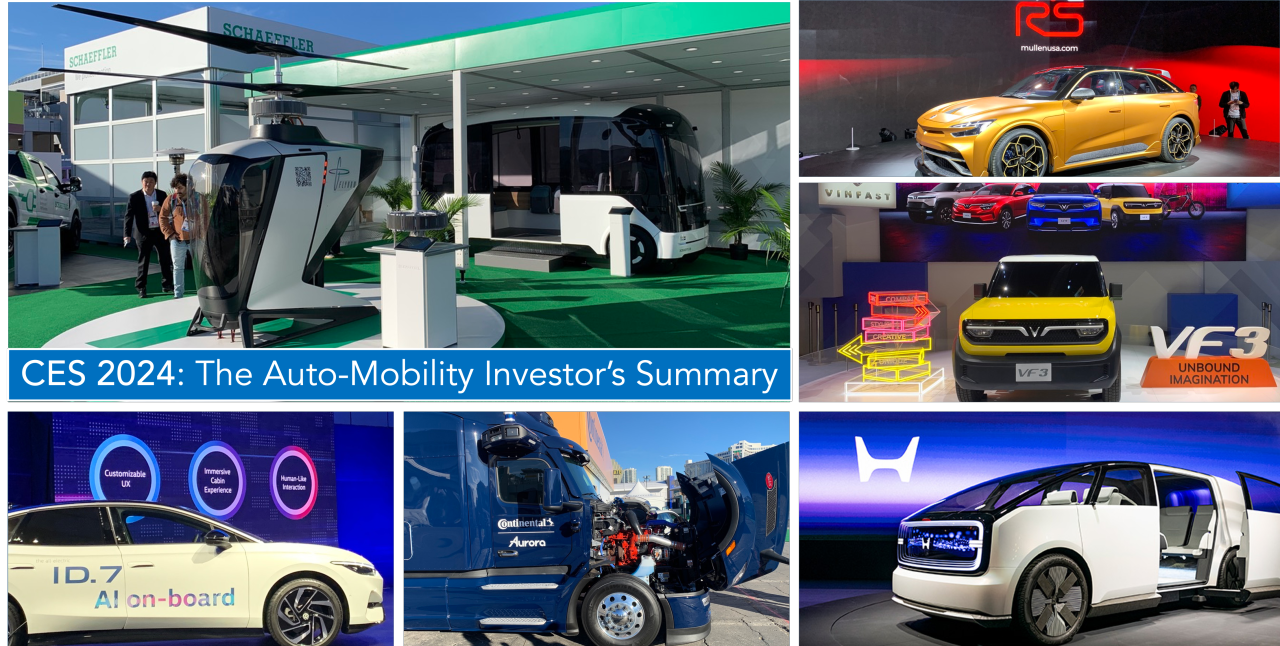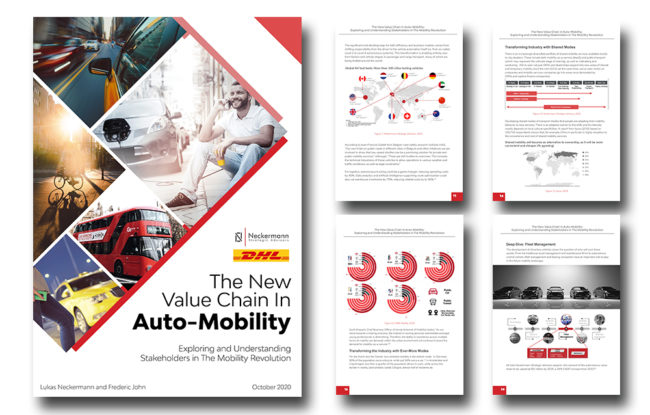As we’ve said for almost a decade, the CES has become the single most significant show of trends for the most expensive of consumer electronics devices: the automobile. I’ve taken in as much of the show as 72 hours (and over 40,000 steps) would allow.
As in years before, there was little in the way of carsharing, ridesharing, ridepooling, bikesharing, scootersharing, public and private transport services, or mobility-as-a-service represented at CES 2024, so it’s wholly incomplete as a mobility show (if you again ignore the BUGATTI e-scooter). But it more than made up for it with electrification, automation, and AI trends (this year, it should more aptly have been named the Consumer AI Show).
I highly recommend the thorough summaries by some of my friends and colleagues across the Mobilityverse™: Jonas Seyfferth (here), James Carter (here), Timothy Papandreou (here), Kirsten Korosec (here), Michael Brecht (here). My perspective here is based on our analysis of the value-chain, and adds content relevant to equity investors. There certainly was a lot on offer.
1. AI as your servant
Volkswagen (VOW) and Cerence Inc. (CRNC) hastily added a press conference to CES to show off ChatGPT integration into the ID.7 as well as the Golf (although it didn’t work for journalists and analysts at the show). The idea is a more natural, LLM-guided interaction with the car (“Ida, I’m cold”, instead of “Ida, please increase the temperature”). If you’ve used LLMs, you know it’s “garbage in, garbage out”, and so it was here. Notable though was the ability to differentiate which commands required connectivity, and which didn’t – which will be relevant for any investors assuming always-on, in-car LLMs will add to the (assumed) terabytes of data exchanged between cars and the cloud.
Two other German premium brands showed off quiet innovations that won’t move the needle for investors, but at least staked a claim in the crowded field of AI integrations at CES: Mercedes-Benz AG (MBG) presented its MBUX Virtual Assistant (more elegantly than VW). BMW Group (BMW) showed off augmented reality glasses as well as a somewhat more impressive Amazon (AMZN) Alexa integration – both of which (undeservedly) earned “Worst of Show” awards from the Electronic Frontier Foundation (EFF).
2. Automotive suppliers shine
As last year, and as in real-life, real innovations came from deep within the value-chain. Chips, sensors, and the “back of house” were stars for me. Significantly, Bosch and Qualcomm (QCOM) have together brought out a central automotive computer – merging ADAS and digital cockpit functions together on one Snapdragon Ride Flex system-on-chip (SoC).
Intel Corporation (INTC), who has languished when compared to NVIDIA (NVDA) and to a lesser extent AMD (AMD) in AI, launched its first generation SoC for the software-defined-vehicle (SDV), and announced the acquisition of Silicon Mobility. This is a big play for automotive, and stands in an interesting juxtaposition to Intel’s still controlling stake (99+% of voting shares) in Mobileye (MBLY) – who themselves announced a key partnership with Mahindra Group.
LeddarTech- Automotive Software: Low-Level Sensor Fusion & Perception (LDTC) allowed visitors to experience their L2/L3 ADAS products in car – fusing various sensor types (camera, radar, LiDAR) into one platform – and announced a partnership with Black Sesame Technologies Inc.
Google (GOOGL) Android‘s news felt underwhelming: sending destinations from mobile to car and EVs sharing real-time battery information into Google Maps seems, well, too obvious. Ford Motor Company (F), Renault (RNO), Polestar (PSNY) and others have committed to Android, and there is no doubt that seamless interaction between home (Nest), mobile, and car is enticing. For now, it remains mostly screen mirroring, with a dose of voice-control.
Forvia’s Aptoide Automotive Apps Market is a trojan horse here: an app store – installed in one of three cars – that enables apps with home-to-car continuity, in-car-payments, and plenty of entertainment content as well. FORVIA (FRVIA) also won a total of four CES Innovation Awards (vs. Bosch 2, Conti 1, Magna 1, and Valeo 1), including for their “Skyline Immersive Display”, and impressed me by their commitment to using recycled materials across the products shown.
Valeo (FR:FR) also had a firework of tangible innovation, with wireless charging at 90% efficiency (!) and V2G functionality. Its stand also showcased the ZEEKR极氪 – yet another, GEELY (HK:175) brand, merely three years old, that we’ll hear more from, very soon (“aim to double deliveries in 2024”); it uses the Intel SoC and Mobileye driver-assist. Given the road-fatality epidemic in the US, Valeo’s focus on “democratising” road-safety – including a new Advanced Rider Assistance Systems (ARAS) for motorcycles – was also well noted.
While Schaeffler (XE:SHA) showed a flying something (in title image), and an autonomous shuttle on its stand, the (much) bigger news was its solid-state battery – for which the first customer is due to be announced – alongside €420mn in investment over the next 10 years.
At a stand outside the Convention Center, BMW also demonstrated teleoperated remote parking (also with “Valeo inside”). Not to be outdone, Bosch and VW CARIAD added automated valet charging to this proposition. Once implemented, these are real-life, relevant applications of semi-autonomous technology – although it becomes apparent how far the European OEMs may be behind their Chinese counterparts. SAIC, Great Wall, Geely, and BYD have had automated valet parking for years.
An integration with LLMs, as well as other home electronics seems an obvious next step. For example, Bosch’s Driver Drowsiness Detection system now also connects directly to the brand’s coffee machine.
Finally, the Knight Rider vision is coming to life!

3. Vehicle-makers regain their vision
XPENG (XPEV) has started taking orders for a flying car and Hyundai’s Supernal showed off a second-gen eVTOL (“My favorite thing at CES,” according to Tom’s Guide). Apparently investment money still hasn’t dried up for eVTOL madness, although Lilium‘s (LILM) absence was deafening. Of all the “visionary” things that are likely to hit our streets, most robo-air-taxi firms won’t survive the next recession.
I’ve done a more extensive review of Kia Worldwide‘s PBV concept here. Investors should know that LCVs (vans) are low-margin products with high customizability required. As every commercial vehicle OEM will tell you, Hyundai-Kia’s success in this market will depend on its ability to actually manufacture the variability it promises(welcome to “production hell”). But: it was good to see more visionary thinking from the group.
Honda (JP:7267) showed off the “0 Series” including a new logo and slogan for itself (“How we move you”) and a subbrand, for launch in 2026 – meaning the two models “Saloon” and “Space Hub” (in title image) are far from ready. Their commitment to carbon neutrality by 2050 is half-hearted, and the integration of Level 2+/3 ADAS is late among OEMs, but their approach to lightweighting EVs is novel and notable. The offspring of Honda’s partnership with Sony (SONY), “Afeela” (launched at last year’s CES) was lightly updated; it’s a decent showcase for Sony’s sensors, Microsoft (MSFT) Azure’s digital assistant, and in-car gaming, but a far cry from (ever reaching) production.
I’ve written and been quoted on VINFAST (VFS) at length. They continue to see the US as a key market, as evidenced by an impressive, “Wild” (209 inch / 5.4 meter long and 79 inch / 2 meter wide) pickup truck concept (in title image) that will go up against the F-150 Lightning, Rivian, and Cybertruck (although with much, much greater usability than the latter). Of relevance to investors and customers alike is that it may be built in North Carolina, although that plant’s capacity of 150,000 vehicles seems, ahem, wildly optimistic for the moment.
Speaking of scalable and large, Continental (CON) and Aurora (AUR) released their roadmap to automation of commercial trucking (through 2027). The “Aurora Driver” is the “first serviceable automotive-grade autonomous system at scale”. It’s a PR claim shared by Kodiak (“The Industry-first semi-truck designed for scaled driverless deployment”), who is in its sixth generation of autonomous semi-trucks and this year will be first to go driver-out, with the help of Ambarella Inc SoCs. (Hear our podcast with Daniel Goff and Martin Kahl from December).
B–ON showed its post-StreetScooter future (and Pelkan van) as part of the Foxconn (HNHPF / TW:2317) initiated Open EV alliance, dubbed the “MIH Consortium”. In other news, Amazon’s Zoox was lightly retouched. Mullen Automotive (MULN) – maker of vans and trucks – inexplicably built a 1000bhp electric car (in title image), Turkey’s Togg again showed a “connected smart device” (otherwise called an electric car), and Bollinger Motors again exhibited some trucks.
4. Electric and autonomous everything – and in the public service
Electric motorcycles and bicycles found their way onto the floor at CES, most notably from Segway / Ninebot Inc., with two new models, “Xyber” and “Xafari”. Verge Motorcycles showed off its TS Ultra motorcycle with a hubless rim motor – sure to appear in Hollywood movies soon. Slightly larger and on four wheels, Dutch Squad Mobility launched a world-first solar buggy – alongside one of the few, suitable use-cases for swappable batteries.
What is obvious by now across bikes, trucks, buggies, and cars, was also evident for streetsweepers, military vehicles, boats, excavation trucks and tractors at CES 2024: If it moves, it is now electric and autonomous. And the world of electric autonomous urban mobility has a lot to learn from our rural and off-highway friends. Just note the size and content of John Deere’s (DE) presence to understand.
Clemson University‘s partnership with the US Army yielded the fully autonomous Deep Orange 14. Caterpillar Inc.‘s (CAT) excavator and mining truck certainly took a lot of space in the LVCC, but also emphatically made a point around the electrification of everything. And Brunswick Corporation (BC) emphasized that the dated “ACES” model also holds true on the water, showing off the next generation of electric motors, autonomous boats, as well as launching the “Flite” brand – following the acquisition of Fliteboard in September.
Finally: Remember Lotus Cars Europe, and its impressive new SUV, Eletre? Rethink to Wuhan-based Lotus Technology, and especially Lotus Robotics – an autonomous driving arm with a suite of hardware/software for various, decidedly more mundane urban applications. Such as an electric, autonomous streetsweeper.

Great to see so many friends – old and new – in Las Vegas. My thanks also to Consumer Technology Association for inviting me to be a judge of the CES 2024 Innovation Awards, which gave me keen and deeper insights into the innovations presented across Smart Cities and Future Mobility.
This article was first posted to LinkedIn here.



